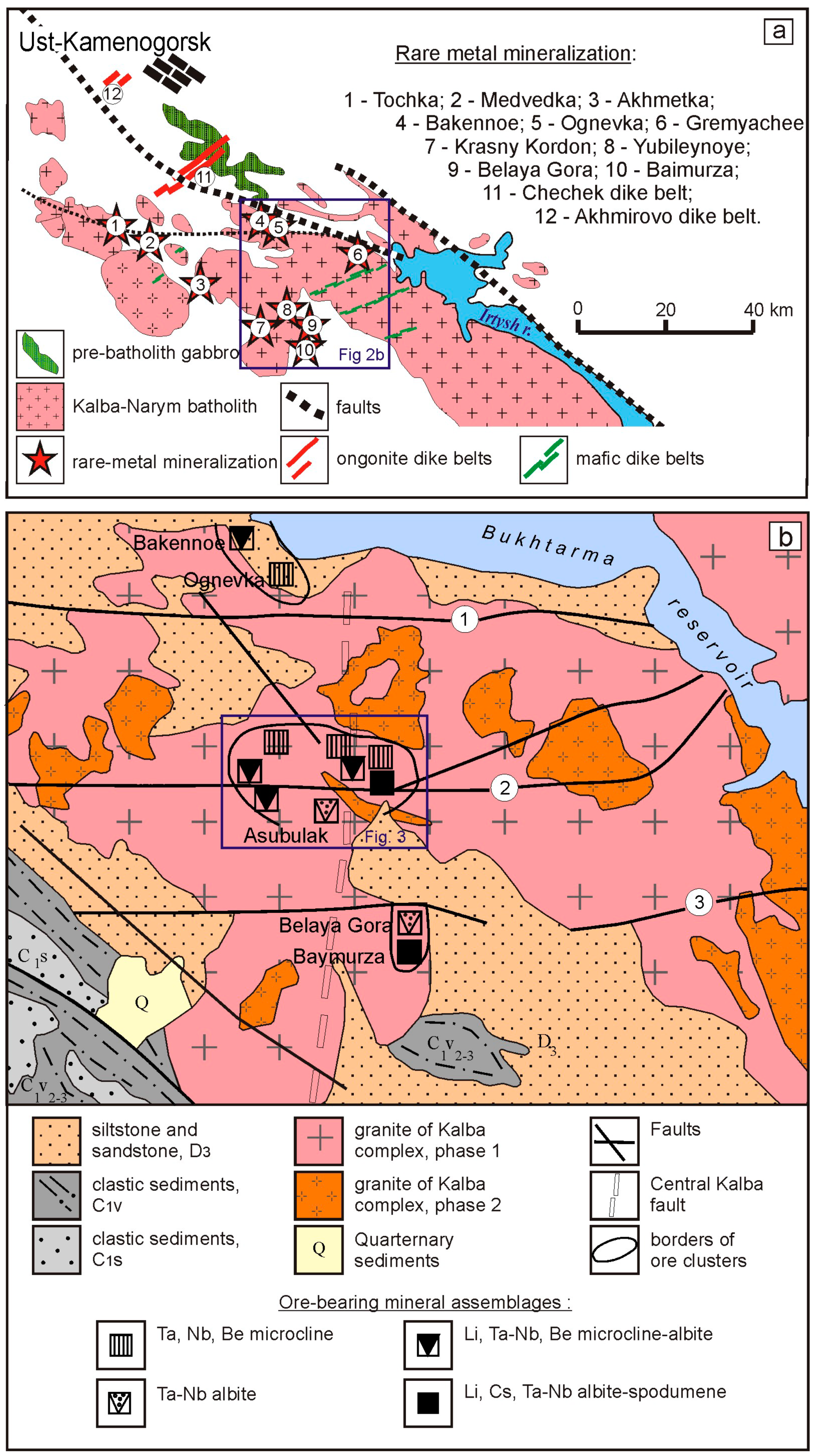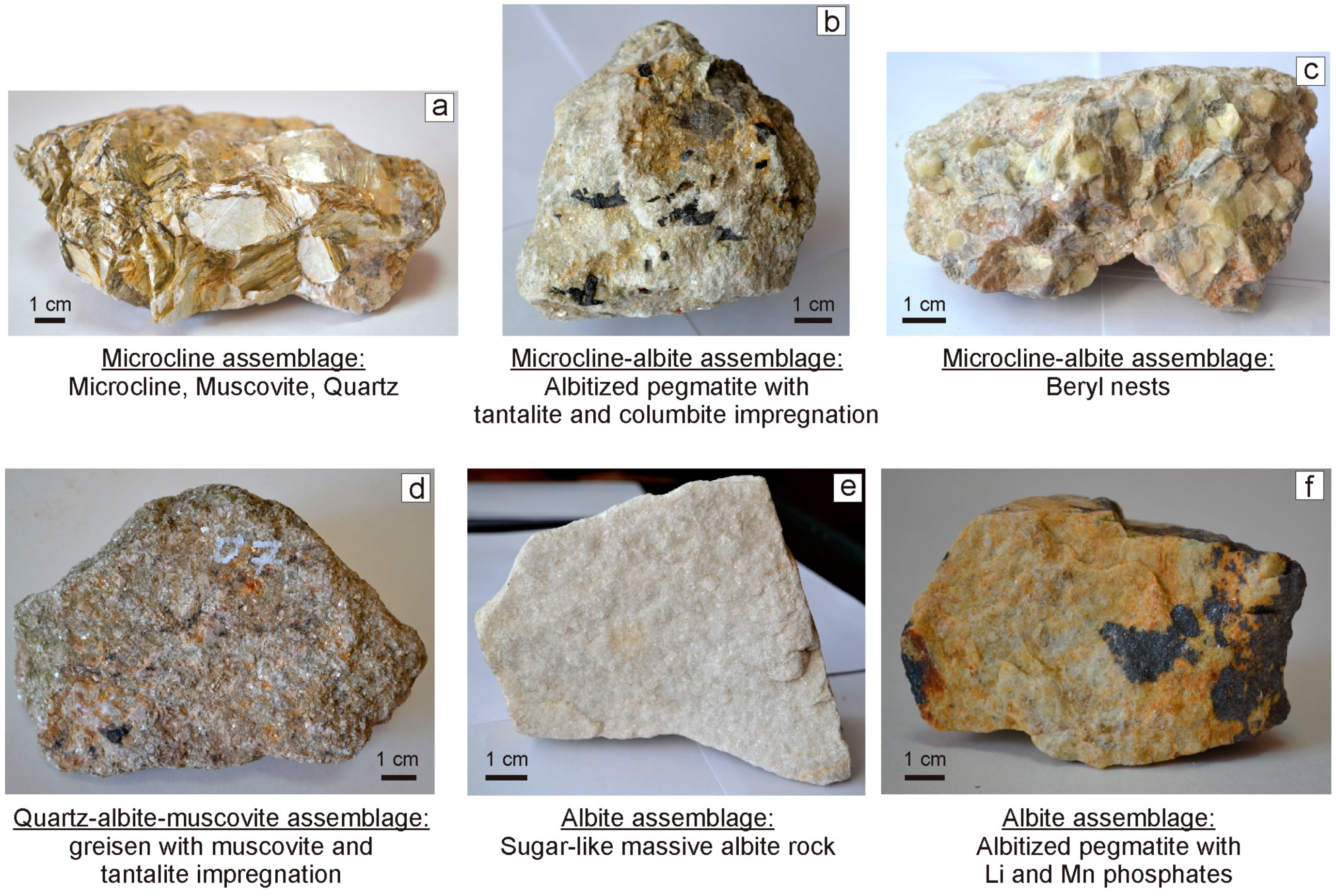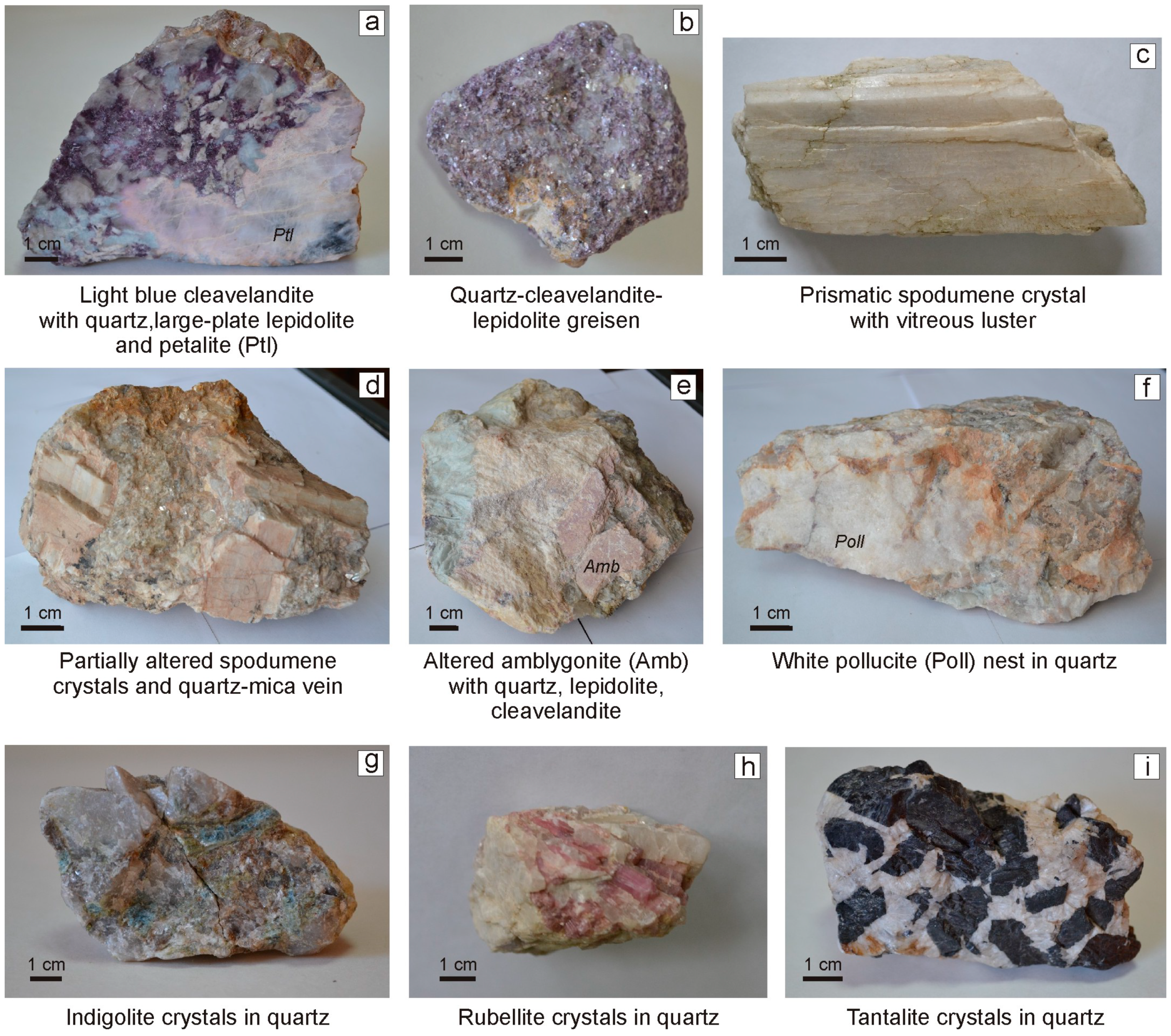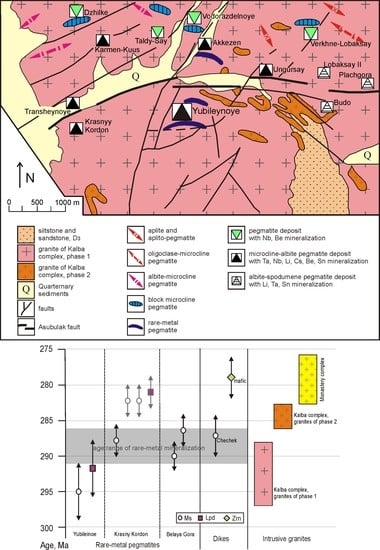Rare-Metal Pegmatite Deposits of the Kalba Region, Eastern Kazakhstan: Age, Composition and Petrogenetic Implications
Abstract
1. Introduction
2. Geological Background
2.1. Tectonic Position
2.2. Kalba Batholith
2.3. Dike Belts
3. Materials and Methods
4. Results
4.1. Rare-Metal Pegmatites: Local Geology
4.2. Mineralogy of Pegmatites
4.3. Geochronology of Rocks and Ores
5. Discussion
6. Conclusions
Supplementary Materials
Author Contributions
Funding
Acknowledgments
Conflicts of Interest
References
- Cerny, P. Rare-element granitic pegmatites. Part I: Anatomy and internal evolution of pegmatite deposits. Geosci. Can. 1991, 18, 49–67. [Google Scholar]
- Pal, D.C.; Mishra, B.; Bernhardt, H.-J. Mineralogy and geochemistry of pegmatite-hosted Sn-, Ta-Nb-, and Zr-Hf-bearing minerals from the southeastern part of the Bastar-Malkangiri pegmatite belt, Central India. Ore Geol. Rev. 2007, 30, 30–55. [Google Scholar] [CrossRef]
- Wang, T.; Tong, Y.; Jahn, B.-M.; Zou, T.-R.; Wang, Y.-B.; Hong, D.-W.; Han, B.-F. SHRIMP U-Pb zircon geochronology of the Altai No. 3 Pegmatite, NW China, and its implications for the origin and tectonic setting of the pegmatite. Ore Geol. Rev. 2007, 32, 325–336. [Google Scholar] [CrossRef]
- Badanina, E.V.; Syritso, L.F.; Volkova, E.V.; Thomas, R.; Trumbull, R.B. Composition of Li-F granite melt and its evolution during the formation of the ore-bearing Orlovka massif in Eastern Transbaikalia. Petrology 2010, 18, 131–157. [Google Scholar] [CrossRef]
- Yarmolyuk, V.V.; Kuzmin, M.I. Late Paleozoic and Early Mesozoic rare-metal magmatism of Central Asia: Stages, provinces, and formation settings. Geol. Ore Deposit. 2012, 54, 313–333. [Google Scholar] [CrossRef]
- Zagorsky, V.; Vladimirov, A.G.; Makagon, V.M.; Kuznetsova, L.G.; Smirnov, S.Z.; D’yachkov, B.A.; Annikova, I.; Shokalsky, S.P.; Uvarov, A.N. Large fields of spodumene pegmatites in the settings of rifting and postcollisional shear-pull-apart dislocations of continental lithosphere. Russ. Geol. Geophys. 2014, 55, 237–251. [Google Scholar] [CrossRef]
- Kuznetsova, L.G. Interaction of crustal and mantle materials, sources of trace elements during the formation and evolution of Early Paleozoic Li-rich granite-pegmatite systems in southeastern Tuva. Russ. Geol. Geophys. 2018, 59, 1660–1678. [Google Scholar] [CrossRef]
- London, D. Ore-forming processes within granitic pegmatites. Ore Geol. Rev. 2018, 101, 349–383. [Google Scholar] [CrossRef]
- Tkachev, A.V.; Rundqvist, D.V.; Vishnevskaya, N.A. Metallogeny of lithium through geological time. Russ. J. Earth Sci. 2018, 18, 1–13. [Google Scholar] [CrossRef]
- Dittrich, T.; Seifert, T.; Schulz, B.; Hagemann, S.; Gerdes, A.; Pfänder, J. Archean Rare-Metal Pegmatites in Zimbabwe and Western Australia. Springer Briefs in World Mineral Deposits; Springer: Cham, Switzerland, 2019; 125p. [Google Scholar] [CrossRef]
- Tkachev, A.V. Evolution of metallogeny of granitic pegmatite associated with orogens throughout geological time. Geol. Soc. Spec. Publ. 2011, 350, 7–23. [Google Scholar] [CrossRef]
- Kovalenko, V.I.; Kostitsyn, Y.A.; Yarmolyuk, V.V.; Budnikov, S.V.; Kovach, V.P.; Kotov, A.B.; Sal’nikova, E.B.; Antipin, V.S. Magma sources and the isotopic (Sr and Nd) evolution of Li-F rare-metal granites. Petrology 1999, 7, 383–409. [Google Scholar]
- Yarmolyuk, V.V.; Kuzmin, M.I.; Ernst, R.E. Intraplate geodynamics and magmatism in the evolution of the Central Asian Orogenic Belt. J. Asian Earth Sci. 2014, 93, 158–179. [Google Scholar] [CrossRef]
- Windley, B.F.; Alexeiev, D.; Xiao, W.; Kröner, A.; Badarch, G. Tectonic models for accretion of the Central Asian Orogenic Belt. J. Geol. Soc. 2007, 164, 31–47. [Google Scholar] [CrossRef]
- Vladimirov, A.G.; Kruk, N.N.; Khromykh, S.V.; Polyansky, O.P.; Chervov, V.V.; Vladimirov, V.G.; Travin, A.V.; Babin, G.A.; Kuibida, M.L.; Khomyakov, V.D. Permian magmatism and lithospheric deformation in the Altai caused by crustal and mantle thermal processes. Russ. Geol. Geophys. 2008, 49, 468–479. [Google Scholar] [CrossRef]
- Xiao, W.J.; Huang, B.; Han, C.; Sun, S.; Li, J. A review of the western part of the Altaids: A key to understanding the architecture of accretionary orogens. Gondwana Res. 2010, 18, 253–273. [Google Scholar] [CrossRef]
- Zonenshain, L.P.; Kuzmin, M.I.; Natapov, L.M. Geology of the USSR: A Plate Tectonic Synthesis. Geodynamic Series 21; American Geophysical Union: Washington, DC, USA, 1990; p. 242. [Google Scholar]
- Khromykh, S.V.; Tsygankov, A.A.; Kotler, P.D.; Navozov, O.V.; Kruk, N.N.; Vladimirov, A.G.; Travin, A.V.; Yudin, D.S.; Burmakina, G.N.; Khubanov, V.B.; et al. Late Paleozoic granitoid magmatism of Eastern Kazakhstan and Western Transbaikalia: Plume model test. Russ. Geol. Geophys. 2016, 57, 773–789. [Google Scholar] [CrossRef]
- Travin, A.V.; Boven, A.; Plotnikov, A.V.; Vladimirov, V.G.; Theunissen, K.; Vladimirov, A.G.; Melnikov, A.I.; Titov, A.V. Ar-40/Ar-39 dating of ductile deformations in the Irtysh shear zone, Eastern Kazakhstan. Geochem. Int. 2001, 39, 1237–1241. [Google Scholar]
- Glorie, S.; De Grave, J.; Delvaux, D.; Buslov, M.M.; Zhimulev, F.I.; Vanhaecke, F.; Elburg, M.A.; Van den Haute, P. Tectonic history of the Irtysh shear zone (NE Kazakhstan): New constraints from zircon U/Pb dating, apatite fission track dating and palaeostress analysis. J. Asian Earth Sci. 2012, 45, 138–149. [Google Scholar] [CrossRef]
- Li, P.; Sun, M.; Rosenbaum, G.; Cai, K.; Yu, Y. Structural evolution of the Irtysh Shear Zone (northwestern China) and implications for the amalgamation of arc systems in the Central Asian Orogenic Belt. J. Struct. Geol. 2015, 80, 142–156. [Google Scholar] [CrossRef]
- Ermolov, P.V. Current Problems of Isotopic Geology and Metallogeny of Kazakhstan; Kazakh-Russian University: Karaganda, Kazakhstan, 2013; 206p. (In Russian) [Google Scholar]
- Lopatnikov, V.V.; Izokh, E.P.; Ermolov, P.V.; Ponomareva, A.P.; Stepanov, A.S. Magmatism and Metallogeny of the Kalba-Narym Zone, Eastern Kazakhstan; Nauka: Moscow, Russia, 1982; 248p. (In Russian) [Google Scholar]
- D’yachkov, B.A.; Mayorova, N.P.; Shcherba, G.N.; Abdrakhmanov, K.A. Granitoids and Ore-Bearing Mineral Assemblages in the Kalba-Narym Belt (Rudny Altai); Gylym: Almaty, Kazakhstan, 1994; 208p. (In Russian) [Google Scholar]
- Shcherba, G.N.; D’yachkov, B.A.; Stuchevsky, N.I.; Nakhtigal, G.P.; Antonenko, A.N.; Lubetsky, V.N. Great Altai: Geology and Metallogeny. Book 1. Geological Construction; Gylym: Almaty, Kazakhstan, 1998; 304p. (In Russian) [Google Scholar]
- Kotler, P.D.; Khromykh, S.V.; Vladimirov, A.G.; Navozov, O.V.; Travin, A.V.; Karavaeva, G.S.; Kruk, N.N.; Murzintsev, N.G. New data on the age and geodynamic interpretation of the Kalba-Narym granitic batholith, Eastern Kazakhstan. Dokl. Earth Sci. 2015, 462, 565–569. [Google Scholar] [CrossRef]
- Khromykh, S.V.; Kotler, P.D.; Izokh, A.E.; Kruk, N.N. A review of Early Permian (300–270 Ma) magmatism in Eastern Kazakhstan and implications for plate tectonics and plume interplay. Geodyn. Tectonophys. 2019, 10, 79–99. [Google Scholar] [CrossRef]
- Oitseva, T.A.; D’yachkov, B.A.; Vladimirov, A.G.; Kuzmina, O.N.; Ageeva, O.V. New data on the substantial composition of Kalba rare metal deposits. In IOP Conference Series: Earth and Environmental Science; IOP Publishing: Bristol, UK, 2017; Volume 110, p. 012018. [Google Scholar] [CrossRef]
- Rudnick, R.L.; Gao, S. Composition of the Continental Crust. In Treatise on Geochemistry; Holland, H.D., Turekian, K.K., Eds.; Elsevier Science: Amsterdam, The Netherlands, 2003; Volume 3, pp. 1–64. [Google Scholar] [CrossRef]
- D’yachkov, B.A. Genetic Types of Rare-Metal Deposits in the Kalba-Narym Belt; EKSTU: Ust-Kamenogorsk, Kazakhstan, 2012; p. 130. (In Russian) [Google Scholar]
- Sokolova, E.N.; Smirnov, S.Z.; Khromykh, S.V. Conditions of crystallization, composition, and sources of rare-metal magmas forming ongonites in the Kalba-Narym zone, Eastern Kazakhstan. Petrology 2016, 24, 153–177. [Google Scholar] [CrossRef]
- Khromykh, S.V.; Sokolova, E.N.; Smirnov, S.Z.; Travin, A.V.; Annikova, I.Y. Geochemistry and age of rare-metal dyke belts in Eastern Kazakhstan. Dokl. Earth Sci. 2014, 459, 1587–1591. [Google Scholar] [CrossRef]
- Travin, A.V.; Yudin, D.S.; Vladimirov, A.G.; Khromykh, S.V.; Volkova, N.I.; Mekhonoshin, A.S.; Kolotilina, T.B. Thermochronology of the Chernorud granulite zone, Ol’khon Region, Western Baikal area. Geochem. Int. 2009, 47, 1107–1124. [Google Scholar] [CrossRef]
- D’yachkov, B.A.; Nikitina, T.I.; Ermolenko, A.E. Geology and Mineral Potential of Yubileynoe Pegmatitic Deposits in Central Kalba; VKGTU: Ust-Kamenogorsk, Kazakhstan, 1987; 262p. (In Russian) [Google Scholar]







| Zone of Ore Cluster | Western Part | Center Part | Eastern Part |
|---|---|---|---|
| Pegmatite type | Microcline-albite with pollucite and petalite | Microcline-albite, albite, with spodumene | Spodumene-albite |
| Mineralization | Ta, Cs, Be, Sn | Ta, Nb, Cs, Li, Be, Sn | Li, Ta, Nb, Sn |
| Example | Karmen-Kuus, Krasny Kordon | Ungursay, Yubileynoye | Lobaksay, Plachgora, Budo |
| I. Plagioclases | ||||||||
| Sample | n | SiO2 | Al2O3 | CaO | Na2O | K2O | P2O5 | |
| VK-1. Biotite granite. Phase 1 Kalba complex | 30 | 62.93 | 23.09 | 4.36 | 9.09 | 0.21 | – | |
| VK-2. Albite-microcline pegmatite, near Yubileinoye deposit | 6 | 67.51 | 19.83 | 1.03 | 11.35 | 0.17 | – | |
| VK-5. Albite pegmatite with turmaline, Yubileinoye deposit | 5 | 66.81 | 19.02 | – | 11.03 | – | – | |
| VK-9. Albite-lepidolite greisen, Transheinoye deposit | 4 | 67.22 | 19.34 | 0.17 | 11.40 | – | – | |
| VK-10. Albite pegmatite with spodumene, Transheinoye deposit | 9 | 67.77 | 19.74 | 0.17 | 11.67 | 0.12 | 0.33 | |
| II. K-Feldspars | ||||||||
| Sample | n | SiO2 | Al2O3 | Na2O | K2O | |||
| VK-1. Biotite granite. Phase 1 Kalba complex | 22 | 66.07 | 17.54 | 0.66 | 15.20 | |||
| VK-2. Albite-microcline pegmatite, near Yubileinoye deposit | 15 | 64.11 | 18.36 | 0.37 | 16.26 | |||
| VK-10. Albite pegmatite with spodumene, Transheinoye deposit | 2 | 64.54 | 18.16 | 0.33 | 15.50 | |||
| III. Muscovites | ||||||||
| Sample | n | SiO2 | Al2O3 | FeO | MnO | Na2O | K2O | F |
| VK-1. Biotite granite. Phase 1 Kalba complex | 4 | 46.04 | 32.11 | 2.31 | – | 0.29 | 10.98 | – |
| VK-2. Albite-microcline pegmatite, near Yubileinoye deposit | 3 | 45.86 | 34.03 | 1.77 | – | 0.46 | 10.60 | – |
| VK-5. Albite pegmatite with turmaline, Yubileinoye deposit | 14 | 45.95 | 33.51 | 0.80 | – | 0.34 | 10.50 | 1.38 |
| VK-9. Albite-lepidolite greisen, Transheinoye deposit | 31 | 48.99 | 29.13 | – | 0.32 | 0.34 | 10.67 | 4.65 |
| VK-10. Albite pegmatite with spodumene, Transheinoye deposit | 26 | 45.19 | 37.07 | 0.30 | – | 0.42 | 10.57 | 0.56 |
Publisher’s Note: MDPI stays neutral with regard to jurisdictional claims in published maps and institutional affiliations. |
© 2020 by the authors. Licensee MDPI, Basel, Switzerland. This article is an open access article distributed under the terms and conditions of the Creative Commons Attribution (CC BY) license (http://creativecommons.org/licenses/by/4.0/).
Share and Cite
Khromykh, S.V.; Oitseva, T.A.; Kotler, P.D.; D’yachkov, B.A.; Smirnov, S.Z.; Travin, A.V.; Vladimirov, A.G.; Sokolova, E.N.; Kuzmina, O.N.; Mizernaya, M.A.; et al. Rare-Metal Pegmatite Deposits of the Kalba Region, Eastern Kazakhstan: Age, Composition and Petrogenetic Implications. Minerals 2020, 10, 1017. https://doi.org/10.3390/min10111017
Khromykh SV, Oitseva TA, Kotler PD, D’yachkov BA, Smirnov SZ, Travin AV, Vladimirov AG, Sokolova EN, Kuzmina ON, Mizernaya MA, et al. Rare-Metal Pegmatite Deposits of the Kalba Region, Eastern Kazakhstan: Age, Composition and Petrogenetic Implications. Minerals. 2020; 10(11):1017. https://doi.org/10.3390/min10111017
Chicago/Turabian StyleKhromykh, Sergey V., Tatiana A. Oitseva, Pavel D. Kotler, Boris A. D’yachkov, Sergey Z. Smirnov, Alexey V. Travin, Alexander G. Vladimirov, Ekaterina N. Sokolova, Oxana N. Kuzmina, Marina A. Mizernaya, and et al. 2020. "Rare-Metal Pegmatite Deposits of the Kalba Region, Eastern Kazakhstan: Age, Composition and Petrogenetic Implications" Minerals 10, no. 11: 1017. https://doi.org/10.3390/min10111017
APA StyleKhromykh, S. V., Oitseva, T. A., Kotler, P. D., D’yachkov, B. A., Smirnov, S. Z., Travin, A. V., Vladimirov, A. G., Sokolova, E. N., Kuzmina, O. N., Mizernaya, M. A., & Agaliyeva, B. B. (2020). Rare-Metal Pegmatite Deposits of the Kalba Region, Eastern Kazakhstan: Age, Composition and Petrogenetic Implications. Minerals, 10(11), 1017. https://doi.org/10.3390/min10111017








